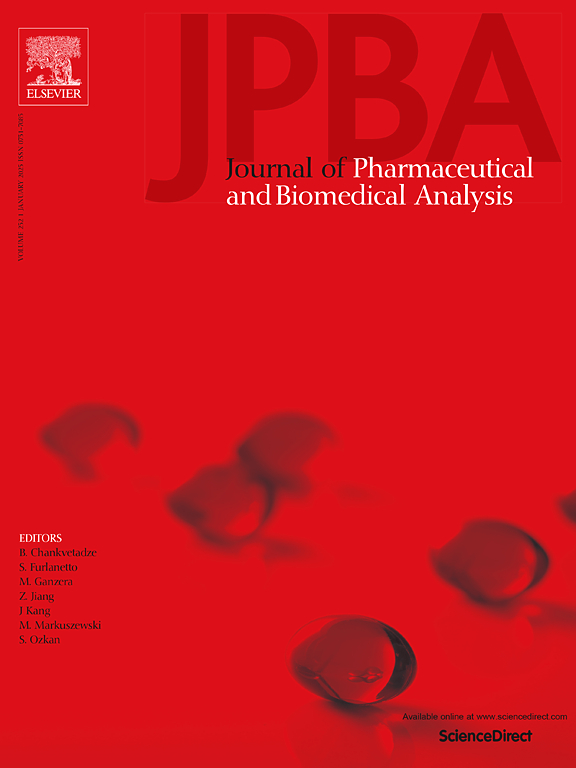Intervention study of Yanghe decoction on plasma cell mastitis based on mammary microecology and metabolomics investigation
IF 3.1
3区 医学
Q2 CHEMISTRY, ANALYTICAL
Journal of pharmaceutical and biomedical analysis
Pub Date : 2025-04-05
DOI:10.1016/j.jpba.2025.116870
引用次数: 0
Abstract
Plasma cell mastitis (PCM), a chronic breast inflammatory disease, is characterized by ductal dilatation and plasma cell infiltration. Traditional Chinese Medicine (TCM) Yanghe decoction is used to relieve mastitis symptoms clinically. However, its efficacy and mechanism on PCM remain undefined. The PCM patients receiving dexamethasone and metronidazole tablets, served as control group, with the other group receiving combination of Yanghe decoction, 15 cases each. Main symptom indicators included mass size, skin colour, skin temperature, breast pain, blood cell count (WBC), C reactive protein (CRP), interleukin (IL)-6, IL-4, serum prolactin (PRL), erythrocyte sedimentation rate (ESR), immunoglobulin A (IgA), IgM, and IgG levels. Secondary indicators included TCM syndrome and anxiety/depression scores. Breast differential flora (DF) and metabolites (DAMs) post-treatment between two groups were detected by 16S rRNA sequencing and metabolomics, with further correlation analysis. Post-treatment symptom scores exhibited lower than pre-treatment in both groups, with greater decline on WBC, CRP, IL-6, IL-4, PRL, and ESR, and enhanced IgA, IgM, and IgG levels in Yanghe decoction group than in control group. Notably, Yanghe decoction group demonstrated no significant DF, with decreased Corynebacterium and Rhodococcus, and elevated Staphylococcus, which correlated significantly with the above indicators. Moreover, 43 DAMs were detected between these two groups, with Glycerophosphocholine, 9,10-Epoxyoctadecenoic acid, Arachidic acid, and 4,5-Dihydroorotic acid showing strong correlations with the above flora. Based on the clarification of PCM improvement with Yanghe decoction, we preliminarily explored potential roles of breast tissue microorganisms and DAMs, providing scientific basis for its clinical application and potential clinical biomarkers in PCM.
基于乳腺微生态学和代谢组学研究的洋河煎剂对浆细胞性乳腺炎的干预研究
浆细胞性乳腺炎(PCM)是一种慢性乳腺炎症性疾病,以导管扩张和浆细胞浸润为特征。中医养和汤在临床上用于缓解乳腺炎的症状。然而,其对PCM的作用机制尚不明确。PCM患者以地塞米松加甲硝唑片治疗为对照组,另一组联合洋河汤治疗,各15例。主要症状指标包括肿块大小、皮肤颜色、皮肤温度、乳房疼痛、血细胞计数(WBC)、C反应蛋白(CRP)、白细胞介素(IL)-6、IL-4、血清泌乳素(PRL)、红细胞沉降率(ESR)、免疫球蛋白A (IgA)、IgM、IgG水平。次要指标包括中医证候和焦虑/抑郁评分。通过16S rRNA测序和代谢组学检测两组治疗后乳腺差异菌群(DF)和代谢物(dam),并进一步进行相关性分析。两组治疗后症状评分均低于治疗前,阳河汤组WBC、CRP、IL-6、IL-4、PRL、ESR下降幅度均大于对照组,IgA、IgM、IgG水平均高于对照组。值得注意的是,洋河汤组DF无明显差异,杆状杆菌和红球菌减少,葡萄球菌升高,与上述指标显著相关。此外,两组间共检测到43个dam,其中甘油磷胆碱、9,10-环氧十八烯酸、花生酸和4,5-二氢糖酸与上述菌群具有较强的相关性。在阐明养和汤改善PCM作用的基础上,初步探讨乳腺组织微生物和dam的潜在作用,为其在PCM中的临床应用和潜在的临床生物标志物提供科学依据。
本文章由计算机程序翻译,如有差异,请以英文原文为准。
求助全文
约1分钟内获得全文
求助全文
来源期刊
CiteScore
6.70
自引率
5.90%
发文量
588
审稿时长
37 days
期刊介绍:
This journal is an international medium directed towards the needs of academic, clinical, government and industrial analysis by publishing original research reports and critical reviews on pharmaceutical and biomedical analysis. It covers the interdisciplinary aspects of analysis in the pharmaceutical, biomedical and clinical sciences, including developments in analytical methodology, instrumentation, computation and interpretation. Submissions on novel applications focusing on drug purity and stability studies, pharmacokinetics, therapeutic monitoring, metabolic profiling; drug-related aspects of analytical biochemistry and forensic toxicology; quality assurance in the pharmaceutical industry are also welcome.
Studies from areas of well established and poorly selective methods, such as UV-VIS spectrophotometry (including derivative and multi-wavelength measurements), basic electroanalytical (potentiometric, polarographic and voltammetric) methods, fluorimetry, flow-injection analysis, etc. are accepted for publication in exceptional cases only, if a unique and substantial advantage over presently known systems is demonstrated. The same applies to the assay of simple drug formulations by any kind of methods and the determination of drugs in biological samples based merely on spiked samples. Drug purity/stability studies should contain information on the structure elucidation of the impurities/degradants.

 求助内容:
求助内容: 应助结果提醒方式:
应助结果提醒方式:


